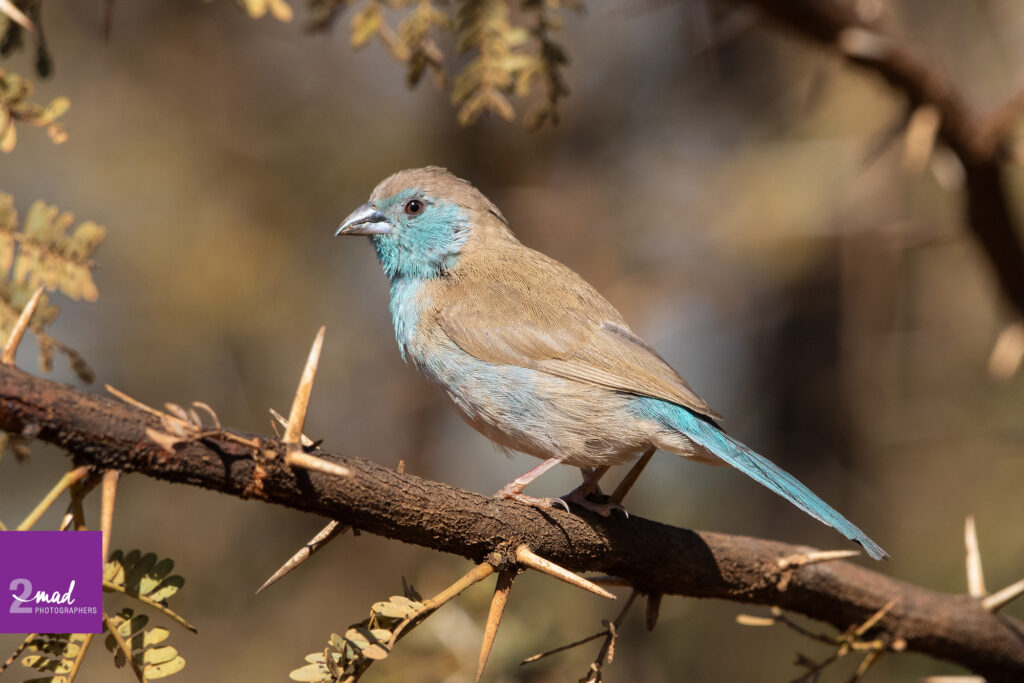Let’s wind the clock back to 2018 when Netra and I travelled to South Africa for the very first time together as wildlife photographers. We had many sleepless nights preparing and psyching ourselves for the trip, meticulously planned to the last detail with all the parks, sewage treatment ponds, bird hides to photograph birds at.
And what an incredible trip it was in the end. Below, I’ll share with you some of our favourite birds we’ve encountered during our travels in this magnificent country.

Netra and I chose to return to Pilanesberg National Park on our last shooting day specifically to find leopards. As we drove past a scrubby area, this Blue Waxbill just flew off the ground from the tall grasses and posed just long enough for her to take the shot out the passenger window. I could only position the car for her to get the best angle. While I missed the shot myself, I am glad Netra got a cracking one! We often let the other person take the shot if one of us is not in the right position. That’s teamwork!

Lilac-breasted Rollers are everywhere in Kruger, or so we thought. They were along every roadway and at times we felt you had to “push them out of the way” so you could aim your camera at other subjects. While common, they are still not easy subjects to photograph.

I remember telling Netra about Intaka Island, that I somehow came across on Facebook. One of our planned stops was Cape Town and while googling things to photograph, it came up. I started to participate in some online discussions with other photographers and a lovely lady invited us with special early access to the photography hides one morning. Charmaine Venter has been a friend ever since, and we still keep in touch hoping to catch-up again when we visit South Africa next. She and her late husband Juan, invited us to join their photography group at Strandfontein Sewage Works the following morning, which was an incredible bird photography spot! Malachite Kingfishers are often seen and photographed at Intaka. We saw our very first with terrible backlighting in Kruger National Park, but the ones at Intaka land close to the hide in pleasing positions. One can NEVER take enough photos of these stunning little kingfishers. They are so tiny! They seem even smaller than our very own Azure Kingfisher in Australia.

Pearl-spotted Owlets are tiny, I found three while driving around with Netra in Kruger National Park over five days of shooting. The first one was when we were travelling at 40km/h down a dirt road, it was sitting in a tree about 30m from the road. I yelled out, “STOP! Reverse the car, there is an owl in that tree!”
Netra and David, our guide, could not believe how I managed to spot this tiny little dumpling of an owl so far from the road. But it really comes down to having honed my observation skills over decades of wildlife photography in the field. The above image was the third one I spotted, and while it’s in a dead tree, its tiny size still made it difficult to see from a distance, as it simply looked like just a piece of broken branch from a distance.

When I spotted some bee-eaters I got very excited, as I know winter is not necessarily the ideal time to find them in southern Africa. From memory, it may have been no more than two or three birds in a tree and we managed a few images before they had enough and took off. If you are lucky in your travels, you can find up to ten different bee-eater species to photograph if you visit South Africa.

One of my bucket list places to photograph birds was Giants Castle in the Drakensberg Mountains west of Durban, where you can photograph Bearded Vultures, a locally endangered species. When I mentioned the photography hide to Netra, she was not aware it even existed, despite her family regularly holidaying in those mountains during her younger years. The hide was built in 1967 and has since catered for bird photographers, giving them incredible opportunities to photograph these spectacular vultures, among other birds.
The property owners put out bones during the winter months and the vultures cruise by on patrol looking for a free feed. With a wingspan of close to 2.8m, they are not speed demons by any stretch of the imagination, so it allows plenty of opportunity to photograph these incredible birds.

Hornbills were fairly common, at least the Southern Yellow-billed were most numerous according to our observations; followed by the Southern Red-billed, and the African Grey Hornbills. These iconic birds were often observed by the side of the road where they were perching close to ground to pounce on their prey.

Magpie Shrikes are striking birds, with that enormous long tail and as they perch by the roadside on the lookout for their insect meals. They are common, and while not strikingly coloured, they are a beautiful addition to our photography collections. When they take off in flight, their motions are spectacularly beautiful!

While the starlings we get to see in Australia are beautiful, nothing could prepare us for the incredible sheens and colours of the ones in South Africa. We were lucky enough to see and photograph Burchell’s and Cape Glossy Starlings. Burchell’s is in the above image.

Sunset Dam in Kruger is a great place to photograph many creatures, from Hippos to kingfishers and everything in between. Normally, a bird angled away from me is not an ideal image and it gets binned. However, here, you can still make out what the kingfisher was up to from the movement of the bird. Things happened so fast, it was difficult to catch any of the activity.